Gujo Hachiman
The Home of Water, Dance and People’s Heart
 Gujo Hachiman is widely known as a Town of Dance and Water. It is located almost at the center of Gifu Prefecture with an area of 242.31 square kilometers and over 16,000 people. The serene Nagara River merges with the Yoshida River around the town center. Gujo Hachiman was developed as a castle town along the Yoshida River. Summer is the time for Gujo Odori Dance which is one of the three largest folk dances in Japan. As many as 50,000 people all dance together throughout the night of the Obon (mid-August).
Gujo Hachiman is widely known as a Town of Dance and Water. It is located almost at the center of Gifu Prefecture with an area of 242.31 square kilometers and over 16,000 people. The serene Nagara River merges with the Yoshida River around the town center. Gujo Hachiman was developed as a castle town along the Yoshida River. Summer is the time for Gujo Odori Dance which is one of the three largest folk dances in Japan. As many as 50,000 people all dance together throughout the night of the Obon (mid-August).
Sightseeing Highlights in Gujo Hachiman
Gujo Hachiman Castle
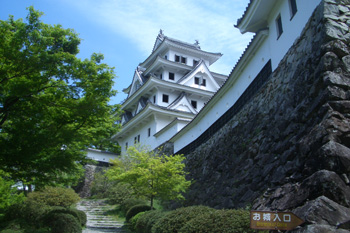 The origin of Gujo Hachiman Castle was a battle base constructed by the samurai lord, Morikazu Endo, in 1559. Afterwards, the Inaba and Endo Clans expended a lot of effort to maintain the fort and in 1667 the 6th-generation castle master, Tsunemoto Endo, undertook a huge renovation. Finally, the Tokugawa shogunate admitted it as an official castle. The Inoue and Kanamori Clans came and settled in the castle in later years. In 1755, a large riot of farmers broke out and the castle master at that time, the 12th-generation master Yorikane Kanamori, was pushed to resign. It is recorded as one of the largest and worst farmer’s riots in the history of Japan (Horeki Sodo). After the riot in 1759, a new lord, Yoshimichi Aoyama, from Miyazu in the Tango region of Kyoto Prefecture, settled in the region in place of the Kanamori Clan and built his residence on the main street of the castle town. The former Ninomaru buildings of the castle were renamed as Sakura-no-maru and Matsu-no-maru. The abolition of feudal domains and the beginning of the establishment of prefectures occurred from 1871 and marked the end of the castle’s history. All of its structures, except for the stone walls, were destroyed. Today, all the stone walls are designated as the historical site of Gifu Prefecture and the restored castle keep is a Tangible Cultural property. A famous Japanese writer, Ryotaro Shiba, praised Gujo Hachiman Castle in one of his essays, “Visiting the Old Roads.”
The origin of Gujo Hachiman Castle was a battle base constructed by the samurai lord, Morikazu Endo, in 1559. Afterwards, the Inaba and Endo Clans expended a lot of effort to maintain the fort and in 1667 the 6th-generation castle master, Tsunemoto Endo, undertook a huge renovation. Finally, the Tokugawa shogunate admitted it as an official castle. The Inoue and Kanamori Clans came and settled in the castle in later years. In 1755, a large riot of farmers broke out and the castle master at that time, the 12th-generation master Yorikane Kanamori, was pushed to resign. It is recorded as one of the largest and worst farmer’s riots in the history of Japan (Horeki Sodo). After the riot in 1759, a new lord, Yoshimichi Aoyama, from Miyazu in the Tango region of Kyoto Prefecture, settled in the region in place of the Kanamori Clan and built his residence on the main street of the castle town. The former Ninomaru buildings of the castle were renamed as Sakura-no-maru and Matsu-no-maru. The abolition of feudal domains and the beginning of the establishment of prefectures occurred from 1871 and marked the end of the castle’s history. All of its structures, except for the stone walls, were destroyed. Today, all the stone walls are designated as the historical site of Gifu Prefecture and the restored castle keep is a Tangible Cultural property. A famous Japanese writer, Ryotaro Shiba, praised Gujo Hachiman Castle in one of his essays, “Visiting the Old Roads.”
Gujo Hachiman Hakuran-kan Museum
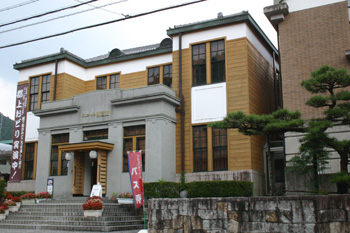 The building was built in the Taisho period (1912-1926) and was used as a former tax office. Keeping its historical atmosphere, it welcomes visitors as a museum today where people can learn about history, tradition, the water environment and Gujo Odori Dance under the theme of “The Hometown of Water, Dance and People’s Heart.” A Gujo Odori Dance performance is held five times a day on weekdays (11:00, 12:00, 13:00, 14:00, 15:00) and seven times a day on weekends (additional shows at 10:00 and 16:00).
The building was built in the Taisho period (1912-1926) and was used as a former tax office. Keeping its historical atmosphere, it welcomes visitors as a museum today where people can learn about history, tradition, the water environment and Gujo Odori Dance under the theme of “The Hometown of Water, Dance and People’s Heart.” A Gujo Odori Dance performance is held five times a day on weekdays (11:00, 12:00, 13:00, 14:00, 15:00) and seven times a day on weekends (additional shows at 10:00 and 16:00).
Former Gujo Hachiman Town Hall Memorial Museum
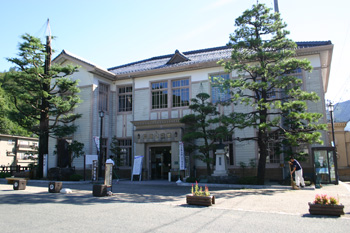 A convenient public space for tourists visiting Gujo Hachiman. Enjoy a nice view of the Yoshida River from Shinbashi Bridge while taking a break during your exploration. The building used to be the Town Hall of Gujo Hachiman and is designated as a National Cultural Property. The interior displays local specialties and crafts as well as a café “Former City Hall Diner” which serves light meals using items from the town. On the second floor, there is an experience hall “KAWASAKI Hall” where people can enjoy Gujo Hachiman Dance. Gujo Hachiman Tourism Association is also located here, so tourists can get all kinds of information about the town such as seasonal recommendations, major highlights of the town and must-try food. The friendly staff will introduce the town with their local dialect.
A convenient public space for tourists visiting Gujo Hachiman. Enjoy a nice view of the Yoshida River from Shinbashi Bridge while taking a break during your exploration. The building used to be the Town Hall of Gujo Hachiman and is designated as a National Cultural Property. The interior displays local specialties and crafts as well as a café “Former City Hall Diner” which serves light meals using items from the town. On the second floor, there is an experience hall “KAWASAKI Hall” where people can enjoy Gujo Hachiman Dance. Gujo Hachiman Tourism Association is also located here, so tourists can get all kinds of information about the town such as seasonal recommendations, major highlights of the town and must-try food. The friendly staff will introduce the town with their local dialect.
Sogisui Water
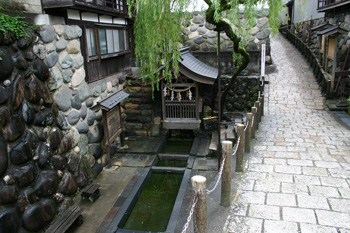 There used to be a natural spring along Kodara River, near Miyagase Bridge. Cold in summer and warm in winter, the water was an important blessing from nature for the local people. The water was so clear that it was often called Shimizu (pure water), too.
There used to be a natural spring along Kodara River, near Miyagase Bridge. Cold in summer and warm in winter, the water was an important blessing from nature for the local people. The water was so clear that it was often called Shimizu (pure water), too.
It is said that Sogi Iio, the grand master of Japanese poetry lived at this place in the 15th century.
It was selected as first place by the former Minister of Environment of the Best 100 Spring Waters in Japan.
YANAKA Water Path and “YANAKA Three Museums”
 Taking a single turn from a bustling main street and walking into this little lane will soothe your heart with its beautiful gravel-covered road (using about 80,000 natural gravel stones from the Nagara and Yoshida Rivers; the number is associated with the name of the town, Gujo Hachiman, which includes the number “eight” in its name in Japanese), a water canal, swaying willow trees and a massive samurai residence. There are two museums along the street: Saito Museum and Yudokan Museum.
Taking a single turn from a bustling main street and walking into this little lane will soothe your heart with its beautiful gravel-covered road (using about 80,000 natural gravel stones from the Nagara and Yoshida Rivers; the number is associated with the name of the town, Gujo Hachiman, which includes the number “eight” in its name in Japanese), a water canal, swaying willow trees and a massive samurai residence. There are two museums along the street: Saito Museum and Yudokan Museum.
IGAWA Path
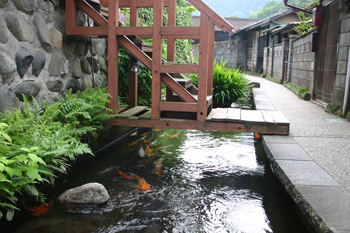 By the Former Gujo Hachiman Town Hall Memorial Museum, there is a pretty small canal where Koi carp and fish swim happily. The canal runs through the town, just behind the private houses, and is where one can find a basket in the water with ayu sweet fish kept inside in summer. There is also an old washing place where local housewives come together and do washing while enjoy chatting with each other.
By the Former Gujo Hachiman Town Hall Memorial Museum, there is a pretty small canal where Koi carp and fish swim happily. The canal runs through the town, just behind the private houses, and is where one can find a basket in the water with ayu sweet fish kept inside in summer. There is also an old washing place where local housewives come together and do washing while enjoy chatting with each other.
Important Annual Events in Gujo Hachiman
Kanzarashi of Gujo Indigo Dyeing Koi-nobori
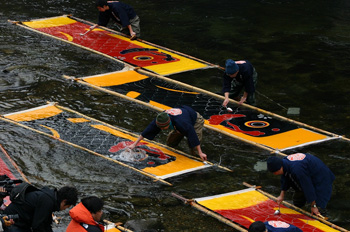 Gujo Honzome (city’s intangible cultural property) is a traditional indigo dyeing process from the town developed by a craftsman, Kazuyoshi Watanabe. The superb color of indigo is called and praised as “Japan Blue” internationally. On the day of Daikan (around January 20), Koi-nobori (a large koi carp streamer made with fabric) dyed with the Kachin-zome technique will “swim” in the Yoshida River. Gujo Honzome is enjoyed not only as Koi-nobori but also as tapestry, casual table center, coaster, and for many more items.
Gujo Honzome (city’s intangible cultural property) is a traditional indigo dyeing process from the town developed by a craftsman, Kazuyoshi Watanabe. The superb color of indigo is called and praised as “Japan Blue” internationally. On the day of Daikan (around January 20), Koi-nobori (a large koi carp streamer made with fabric) dyed with the Kachin-zome technique will “swim” in the Yoshida River. Gujo Honzome is enjoyed not only as Koi-nobori but also as tapestry, casual table center, coaster, and for many more items.
Gujo Dance
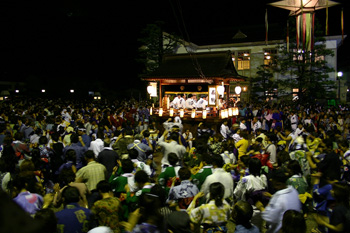 “When leaving Gujo Hachian Town, my sleeves were wet even though I wasn’t caught in the rain (people enjoy Gujo Hachiman Dance so hard that they get very sweaty but don’t notice it).” This is a lyric from a famous song and dance about the Gujo Hachiman Dance which people have been familiar with for over 400 years. Originally, the local samurai governor encouraged the Bon Odori dance in summer in order to establish friendship among the people in his domain. Of course, tourists are welcome to join the dance as the Gujo Hachiman This is a dance not for just watching but for joining. The long period of dancing starts from mid-July and continues to early September; a total of over 30 nights. Every night somewhere in the town, people enjoy dancing. There are 10 different songs for dance, from slow tempo to fast, which people of all ages can join and enjoy together. About 300,000 tourists join the dance every year from around Japan.Gujo Odori was registered as a UNESCO Intangible Cultural Heritage in 2022.
“When leaving Gujo Hachian Town, my sleeves were wet even though I wasn’t caught in the rain (people enjoy Gujo Hachiman Dance so hard that they get very sweaty but don’t notice it).” This is a lyric from a famous song and dance about the Gujo Hachiman Dance which people have been familiar with for over 400 years. Originally, the local samurai governor encouraged the Bon Odori dance in summer in order to establish friendship among the people in his domain. Of course, tourists are welcome to join the dance as the Gujo Hachiman This is a dance not for just watching but for joining. The long period of dancing starts from mid-July and continues to early September; a total of over 30 nights. Every night somewhere in the town, people enjoy dancing. There are 10 different songs for dance, from slow tempo to fast, which people of all ages can join and enjoy together. About 300,000 tourists join the dance every year from around Japan.Gujo Odori was registered as a UNESCO Intangible Cultural Heritage in 2022.
Gujo Hachiman Castle Town Firework Festival
 Gorgeous fireworks displayed near the castle keep of Gujo Hachiman Castle which can be viewed from almost anywhere in the town. Some tricky fireworks will entertain the audience by the Yoshida River.
Gorgeous fireworks displayed near the castle keep of Gujo Hachiman Castle which can be viewed from almost anywhere in the town. Some tricky fireworks will entertain the audience by the Yoshida River.
Gujo Hachiman Maple Festival
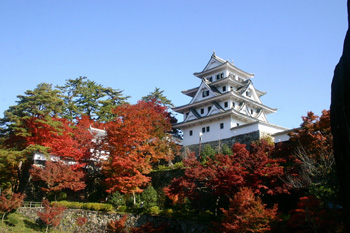 The color contrast between the white castle keep surrounded by red maple leaves offers a stunning view. Many fun events are scheduled during the festival period, especially weekends. Evening light-up will be held, too.
The color contrast between the white castle keep surrounded by red maple leaves offers a stunning view. Many fun events are scheduled during the festival period, especially weekends. Evening light-up will be held, too.
Gujo Hachiman Spring Festival
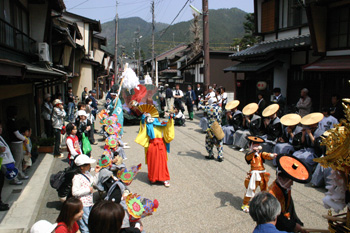 A large spring festival held on the third Saturday and Sunday in April every year. The Dai Kagura (traditional court dance and music performance) at three shrines in the city (Kitsurugi Shrine, Hiyoshi Shrine, Hachiman Shrine) is a must-see.
A large spring festival held on the third Saturday and Sunday in April every year. The Dai Kagura (traditional court dance and music performance) at three shrines in the city (Kitsurugi Shrine, Hiyoshi Shrine, Hachiman Shrine) is a must-see.
Opening of Gujo Ayu Fishing
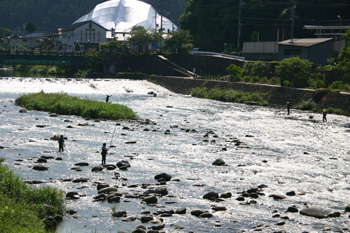 The Nagara River has been claimed one of the most beautiful rivers in Japan. The Yoshida River is a branch of Nagara River and is known as the best fishing spot for ayu sweet fish. Gujo Ayu are recognized as the best ayu in Japan.
The Nagara River has been claimed one of the most beautiful rivers in Japan. The Yoshida River is a branch of Nagara River and is known as the best fishing spot for ayu sweet fish. Gujo Ayu are recognized as the best ayu in Japan.
Takao Kabuki in Ichishima
 At Takao Shrine in the Ichishima district of Hachiman Town, an annual Takao Kabuki show performed by the local people is dedicated to the deity every year. In earlier times, around the late 1950s to early 1960s, there were still some other places where Kabuki by local people (non-professional actors) existed but now this is the only one still remaining.
At Takao Shrine in the Ichishima district of Hachiman Town, an annual Takao Kabuki show performed by the local people is dedicated to the deity every year. In earlier times, around the late 1950s to early 1960s, there were still some other places where Kabuki by local people (non-professional actors) existed but now this is the only one still remaining.
Chitora Hakusan Shrine Sweet Sake Festival
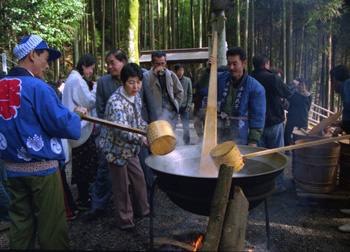 In this area, people have long worshipped the mountains of Hakusan as the deity in the nature since ancient times. “First, the Okaiko Festival in Nagataki and second, the Amazake Festival in Chitora.” This is what people have said in this region and as it claims, this Amazake (Sweet Sake) Festival is just magnificent. A large portion (about 108 liters) of sweet cloudy sake is boiled in a large pot in front of the shrine hall and local people come and sip a cup of sake one by one as their name is called out. When everyone finishes drinking, they roar together and surround the pot and finish all the sake left in the pot. Such a unique festival.
In this area, people have long worshipped the mountains of Hakusan as the deity in the nature since ancient times. “First, the Okaiko Festival in Nagataki and second, the Amazake Festival in Chitora.” This is what people have said in this region and as it claims, this Amazake (Sweet Sake) Festival is just magnificent. A large portion (about 108 liters) of sweet cloudy sake is boiled in a large pot in front of the shrine hall and local people come and sip a cup of sake one by one as their name is called out. When everyone finishes drinking, they roar together and surround the pot and finish all the sake left in the pot. Such a unique festival.
Traditional Crafts of Gujo Hachiman
Gujo Tsumugi Fabric
 Since olden times, weaving fabric was a popular side job in farmer’s families in Gujo Hachiman. A historical story says that members of the defeated Heike Clan fled to this region and started to produce fabric using wild silkworms. They dyed the silk with natural wild plants and sold the fabric to make a living. Sadly, the tradition was almost extinct after the Meiji period, however, a late-Living National Treasure, Rikizo Munehiro, made tremendous effort to revive it and it made a comeback as a local craft today.
Since olden times, weaving fabric was a popular side job in farmer’s families in Gujo Hachiman. A historical story says that members of the defeated Heike Clan fled to this region and started to produce fabric using wild silkworms. They dyed the silk with natural wild plants and sold the fabric to make a living. Sadly, the tradition was almost extinct after the Meiji period, however, a late-Living National Treasure, Rikizo Munehiro, made tremendous effort to revive it and it made a comeback as a local craft today.
Gujo Honzome Dyeing
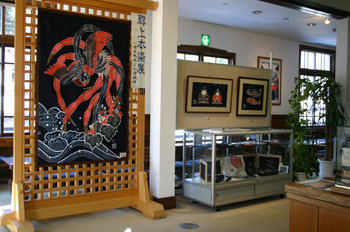 The master technique of Gujo Honzome dyeing has been passed on by the Watanabe Family since the late 16th century. After 430 years, they still follow traditional dyeing methods using wild plants in the field and dye arm and leg guards and work clothes for farmers. In the traditional town of Gujo Hachiman, Watanabe Somemono-ten still opens its door on the Tatemachi Street. The present master, Kazuyoshi Watanabe succeeded the name of the 15th-generation grand master, Yasuhei Hishiya. He is the one and only craftsman who preserves the traditional skills of authentic Japanese aizome indigo dyeing in Japan.
The master technique of Gujo Honzome dyeing has been passed on by the Watanabe Family since the late 16th century. After 430 years, they still follow traditional dyeing methods using wild plants in the field and dye arm and leg guards and work clothes for farmers. In the traditional town of Gujo Hachiman, Watanabe Somemono-ten still opens its door on the Tatemachi Street. The present master, Kazuyoshi Watanabe succeeded the name of the 15th-generation grand master, Yasuhei Hishiya. He is the one and only craftsman who preserves the traditional skills of authentic Japanese aizome indigo dyeing in Japan.
Screen Printing (Silkscreen)
 Silkscreen printing techniques in Japan were born in Gujo Hachiman. It has been one of the most important local industries of the city and many companies produce excellent printing items. At Takara Gallery Workroom, visitors can try making a tenugui cotton towel with screen printing which is an essential item for the Gujo Hachiman Dance. Designs and colors vary depending on the season, so you can make only one tenugui for yourself which will be a good memory from Gujo Hachiman.
Silkscreen printing techniques in Japan were born in Gujo Hachiman. It has been one of the most important local industries of the city and many companies produce excellent printing items. At Takara Gallery Workroom, visitors can try making a tenugui cotton towel with screen printing which is an essential item for the Gujo Hachiman Dance. Designs and colors vary depending on the season, so you can make only one tenugui for yourself which will be a good memory from Gujo Hachiman.
Food & Specialties of Gujo Hachiman
Nikkei-dama
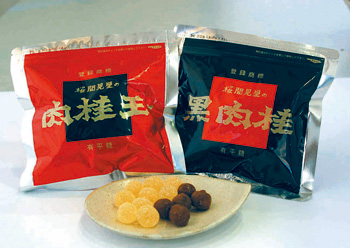 Gujo Hachiman has long produced simple sweets using cinnamon (nikki). Try a traditional sweet taste of Japan.
Gujo Hachiman has long produced simple sweets using cinnamon (nikki). Try a traditional sweet taste of Japan.
Wild Boar Hot Pot
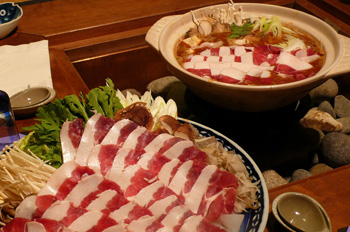 Wild boar hot pot (aka Botan-nabe) is a specialty of the winter season. Wild boar meat is cooked in a tasty miso soup.
Wild boar hot pot (aka Botan-nabe) is a specialty of the winter season. Wild boar meat is cooked in a tasty miso soup.
- Access
- A 20-min. walk from Gujo Hachiman Station on the Nagaragawa Railways via Mino Ota Station on the JR Takayama Main Line
- Contact
- Gujo Hachiman Tourism Association
- TEL:0575-67-0002 / FAX:0575-67-1771
- E-mail: gujoodri@rd.mmtr.or.jp
- URL: http://www.gujohachiman.com/kanko/





